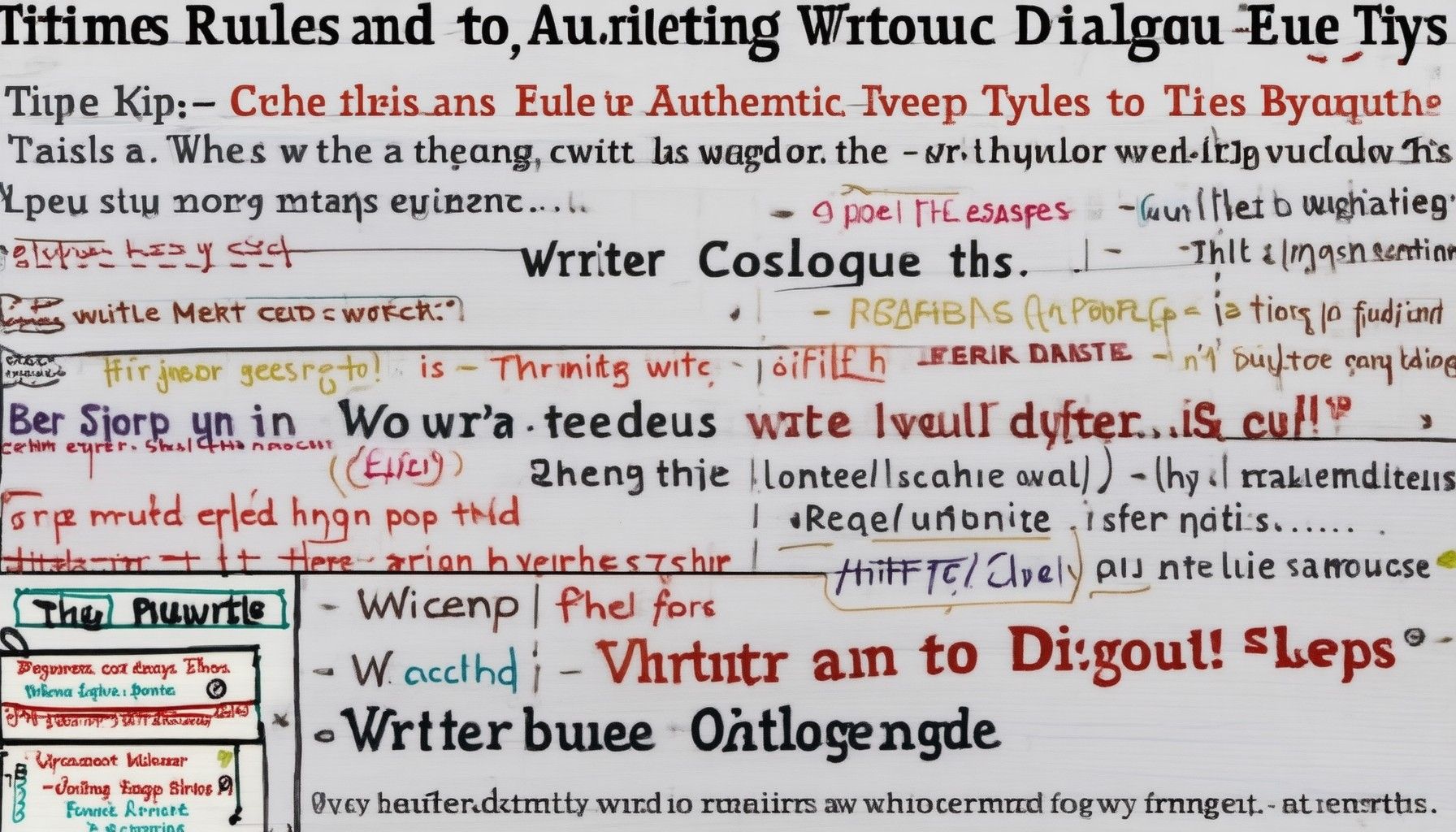Writing authentic dialogue is a cornerstone of great storytelling, allowing readers to connect deeply with characters and immerse themselves in the narrative. Whether crafting a scene or a monologue, the ability to render speech that feels true to its source is crucial for creating believable characters and compelling plots. From capturing the subtle nuances of tone and context to understanding the unspoken subtext beneath words, authentic dialogue goes beyond mere communication—it reflects the essence of who your characters are and what they represent. This guide delves into the techniques, rules, and types of dialogue writing, offering insights into how to master the art of creating conversations that feel natural, meaningful, and deeply human. By exploring the complexities of voice, diction, and purpose, as well as the structural considerations that shape dialogue, this exploration will equip you with the tools to craft dialogue that resonates authentically with your audience.
Key Takeaways
– Master the Four Types of Dialogue: Understand objective, subjective, didactic, and symbolic dialogue to craft authentic and purposeful conversations.
– Enhance Communication Skills: Recognize seven distinct dialogue types—from persuasion to discovery—to tailor interactions effectively.
– Write Authentically: Keep dialogues natural, balance with descriptions, and vary sentence structures to bring characters to life.
– Grasp the Five Elements: Nail tone, diction, structure, purpose, and engagement to deliver clear, impactful messages.

How to Write Authentic Dialogue
Authentic dialogue is crucial for creating relatable and believable characters in your writing. Here’s a step-by-step guide to crafting natural-sounding conversation:
1. Understand the Purpose of Your Dialogue
- Determine the role of the dialogue in your scene. Is it meant to reveal character traits, advance the plot, or establish atmosphere?
- Tailor the dialogue to suit the setting, whether it’s casual conversation or formal speech.
2. Capture Real-Life Speech Patterns
- Incorporate natural pauses, hesitations, and filler words like “um,” “uh,” or “you know.”
- Use contractions (“don’t,” “can’t”) to sound more conversational.
- Reflect regional dialects or accents if applicable.
3. Vary Sentence Structure
- Avoid overly complex sentences in dialogue. Keep it simple and direct.
- Use short sentences to mimic how people speak in real life.
4. Balance Show vs. Tell
- Occasionally describe speech patterns or mannerisms to hint at character traits without dictating every word.
- For example: “She spoke quickly, her words rushing out like she was in a hurry.”
5. Avoid Overstylization
- Steer clear of overly poetic or stylized dialogue that feels forced.
- Authentic dialogue should feel spontaneous and unscripted.
6. Practice Active Listening
- Pay attention to how people around you converse. Notice their unique quirks and phrasing.
- Immerse yourself in different dialects or accents through books, movies, or podcasts.
7. Edit for Natural Flow
- Revise your dialogue to eliminate awkward phrasing or unrealistic expressions.
- Read your dialogue aloud to ensure it sounds natural and fluid.
8. Consider Cultural Context
- Be mindful of cultural differences in communication styles. For example, some cultures may prefer indirect speech, while others value bluntness.
9. Avoid Common Mistakes
- Don’t overuse filler words or make every sentence a complete thought.
- Avoid perfect grammar unless your character is highly educated or formally trained.
10. Get Feedback
- Share your dialogue with trusted readers or writing partners for honest criticism.
- They can offer valuable insights into what feels authentic and what doesn’t.
By focusing on these principles, you’ll develop a skill for writing dialogue that feels genuine and engaging, helping your characters and stories resonate with readers.
What Are the 5 Rules of Writing Dialogue?
- Clarity is Key: Ensure your dialogue is easy to understand. Avoid complex words or sentences that may confuse readers. Use contractions and simple language to mimic real conversation.
- Be Realistic: Characterize your speakers by their personality and situation. Formal characters speak formally, while casual characters use slang. Consistency is crucial for believable dialogue.
- Stay Consistent: Maintain consistent speech patterns for each character. Avoid sudden shifts in dialect or style that feel forced or unnatural to the story.
- Dialogue Should Have Purpose: Every line of dialogue should contribute to the plot, reveal character traits, or advance the story. Avoid unnecessary filler lines that don’t add value.
- Keep Readers Engaged: Use techniques like rhetorical questions, humor, or emotional language to captivate audiences. Vary sentence structure to maintain interest and prevent monotony.

What is an Authentic Dialogue?
An authentic dialogue is a form of communication characterized by open, honest, and respectful exchange of ideas. It operates under principles that foster mutual understanding and collaboration, often referred to as Habermas’ speech conditions. These conditions include symmetry (equal opportunity to speak), reciprocity (mutual exchange of perspectives), equality (treat others with dignity), and freedom (the ability to express oneself without fear of censorship).
The Components of Authentic Dialogue
- Symmetry : Ensures all participants have equal opportunities to contribute to the conversation.
- Reciprocity : Encourages give-and-take interactions, allowing individuals to learn from each other.
- Equality : Promotes respect and dignity among all parties involved.
- Freedom : Protects the rights of individuals to express their views without fear of reprisal.
The Importance of Authentic Dialogue
Authentic dialogue is essential for building trust and fostering meaningful connections. It allows individuals to identify and resolve conflicts constructively, leading to stronger relationships and more cohesive outcomes. By embracing authenticity, participants create an environment where diverse viewpoints can thrive, ultimately enriching the collective understanding of any given topic.
Authentic Dialogue in Writing and Storytelling
Just as James Whitfield Thomson’s website emphasizes the importance of clear and engaging writing, authentic dialogue requires precision in communication. Effective storytelling and narrative development rely on this principle, ensuring that characters and plots resonate deeply with readers. By incorporating authentic dialogue, authors like James Whitfield Thomson can create narratives that feel genuine and relatable, drawing audiences deeper into their stories.
Explore James Whitfield Thomson’s literary insights to discover how his approach to writing aligns with the principles of authentic dialogue.

What Are the 4 Types of Dialogue Writing?
- Objective Dialogue: This type focuses on realistic communication aimed at moving the plot forward or revealing character traits. It often sounds natural and serves the story’s needs.
- Subjective Dialogue: This type explores characters’ thoughts, feelings, and emotions. It allows deeper insight into their personalities and motivations.
- Didactic Dialogue: This type is instructional or expository, used to convey information, lessons, or wisdom. It often feels more formal or deliberate.
- Symbolic Dialogue: This type uses metaphors, symbols, or innuendos to convey deeper meanings or themes. It may require careful interpretation to understand its significance.
Tips for Effective Dialogue Writing:
- Keep conversations natural and true to the characters.
- Use dialogue to reveal character traits and advance the plot.
- Balance dialogue with descriptions and actions to enrich the narrative.
- Vary sentence structures and vocabulary to match the speaker’s personality.
What Are the 7 Types of Dialogue?
The concept of dialogue types is essential in understanding human communication patterns. Below are seven distinct types of dialogue, each serving unique purposes in various contexts:
- Persuasion Dialog : This type aims to influence others’ opinions or actions through logical arguments and emotional appeals. It’s commonly used in marketing, politics, and sales.
- Inquiry Dialog : This involves seeking information or clarification. It’s prevalent in customer service, education, and troubleshooting scenarios.
- Negotiation Dialog : This focuses on reaching a compromise or agreement between parties with differing interests. It’s crucial in conflict resolution and deal-making.
- Information-Seeking Dialog : This occurs when one party seeks knowledge or data from another. It’s common in learning environments and research settings.
- Deliberation Dialog : This involves thoughtful discussion aimed at making decisions or solving complex problems. It’s often seen in group meetings and policy-making.
- Eristic Dialog : This is a debate or discussion focused on testing ideas or challenging assumptions. It promotes critical thinking and intellectual growth.
- Discovery Dialog : This type emphasizes exploration and uncovering new information or perspectives. It’s key in scientific research and creative problem-solving.
Understanding these dialogue types can enhance your communication skills, enabling better interactions in both personal and professional settings.

The Five Elements of Dialogue
Effective dialogue is a cornerstone of successful communication, whether in personal conversations, professional settings, or creative writing. Mastering these five essential elements can significantly enhance your ability to engage, persuade, and connect with others.
1. Tone
The tone of your dialogue reflects your attitude and intentions. It can range from casual and friendly to formal and serious. Matching your tone to the situation ensures your message resonates appropriately:
- Formal: Used in professional or serious contexts, such as in meetings or academic discussions.
- Casual: Suitable for informal settings, like chatting with friends or relaxed workplace interactions.
- Emotional: Conveys feelings and emotions, often used in personal or expressive conversations.
2. Diction
Diction refers to the choice of words and phrases you use. It plays a crucial role in shaping your message’s impact:
- Simplicity: Clarity is key. Avoid overly complex words that may confuse listeners.
- Precision: Use specific terms to convey exact meanings, avoiding ambiguity.
- Emphasis: Highlight important ideas through stress or intonation, guiding the listener’s focus.
3. Structure
Structure determines how your message is organized and delivered. A logical flow helps listeners follow along easily:
- Introduction: Begin with an engaging statement or question to capture attention.
- Body: Present your main points clearly and support them with evidence or examples.
- Conclusion: Summarize your key points and reinforce your message.
4. Purpose
Your dialogue should have a clear purpose, whether it’s to inform, persuade, entertain, or inspire:
- Informative: Sharing facts or knowledge to educate listeners.
- Persuasive: Using logic and emotion to influence opinions or actions.
- Entertaining: Telling jokes or stories to amuse and engage.
- Inspiring: Motivating listeners to take action or adopt a new perspective.
5. Engagement
Engagement keeps the conversation moving and maintains interest:
- Active Listening: Show attentiveness through body language and responses.
- Relevant Questions: Keep the discussion focused by asking meaningful questions.
- Feedback: Acknowledge and respond to others’ contributions.
Conclusion
Mastering these five elements of dialogue allows you to communicate effectively in various situations. By aligning your tone, choosing the right words, organizing your thoughts, staying focused, and engaging thoughtfully, you can foster meaningful connections and convey your message powerfully.





0 Comments